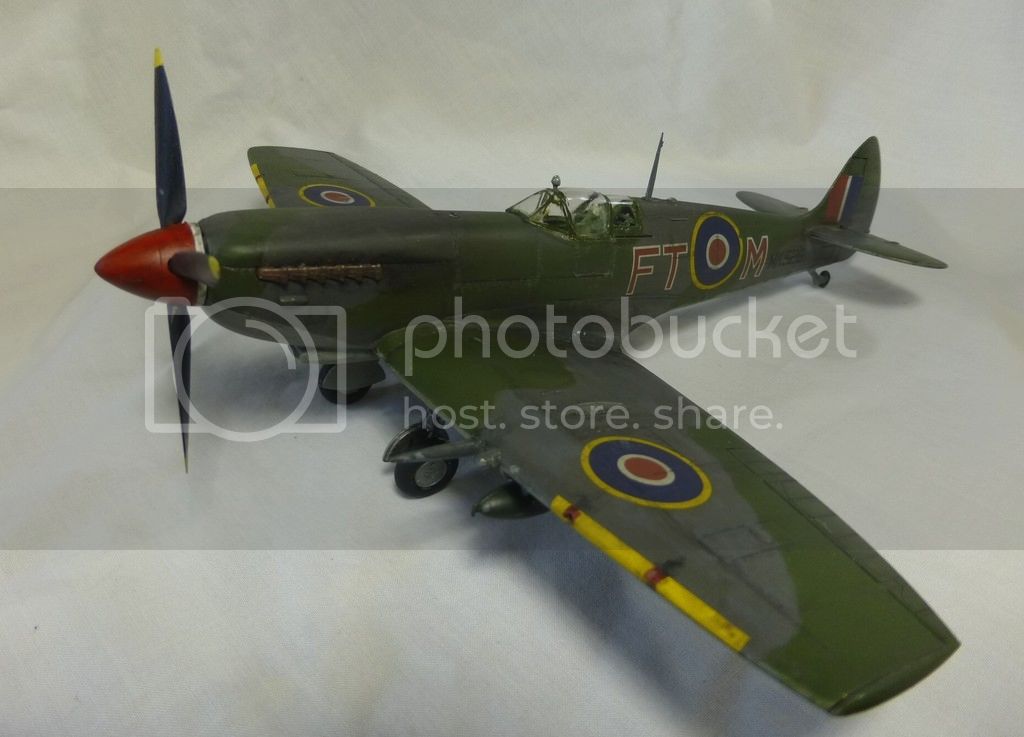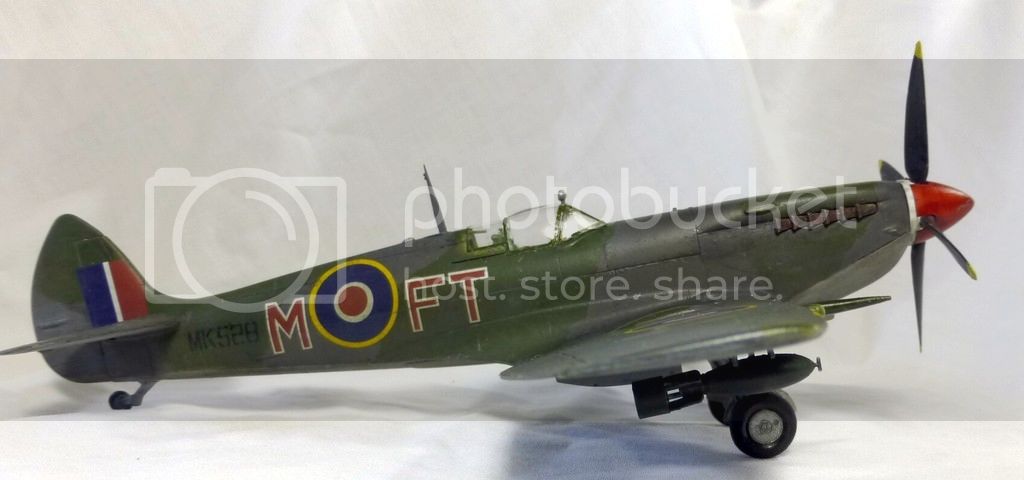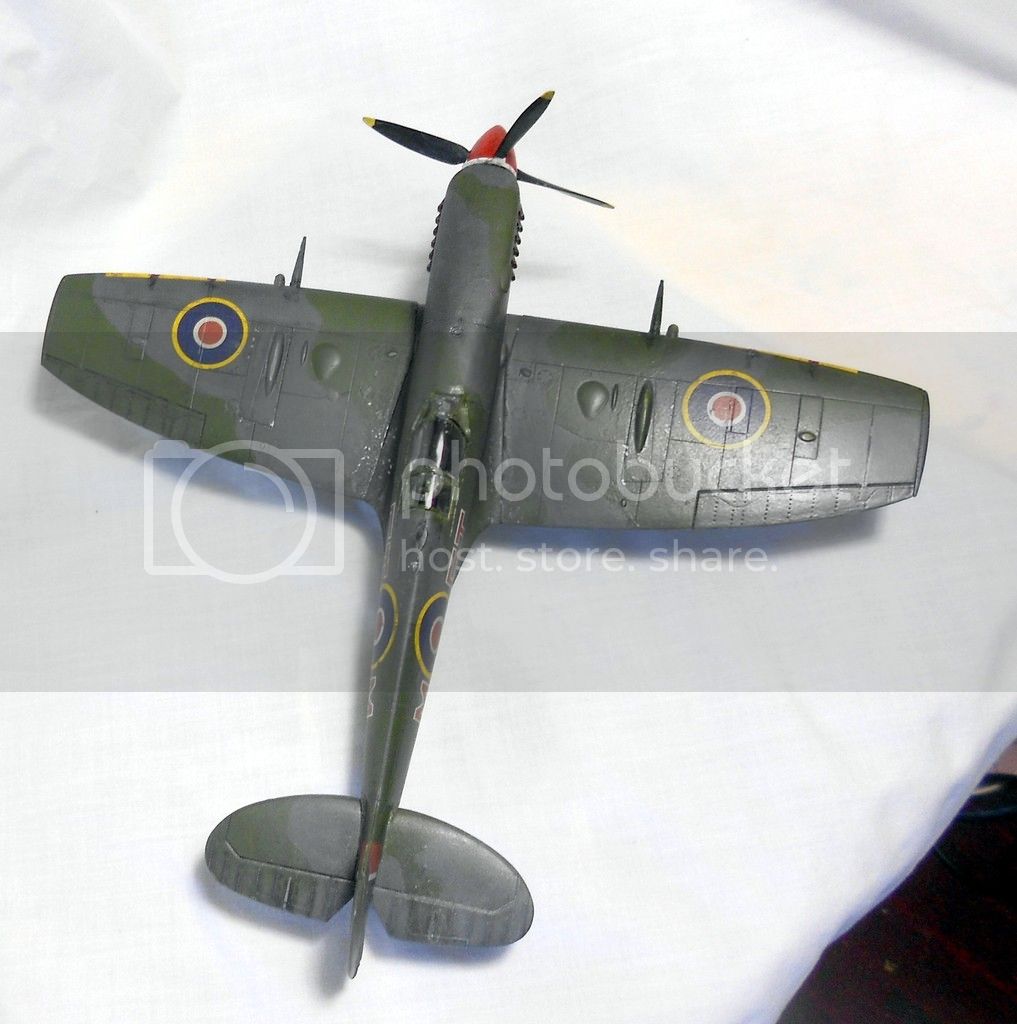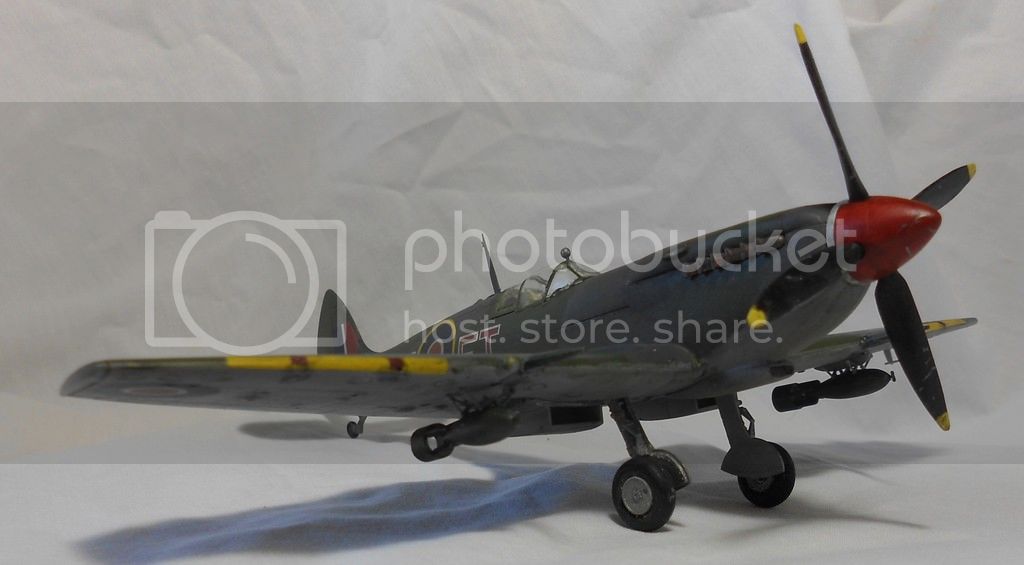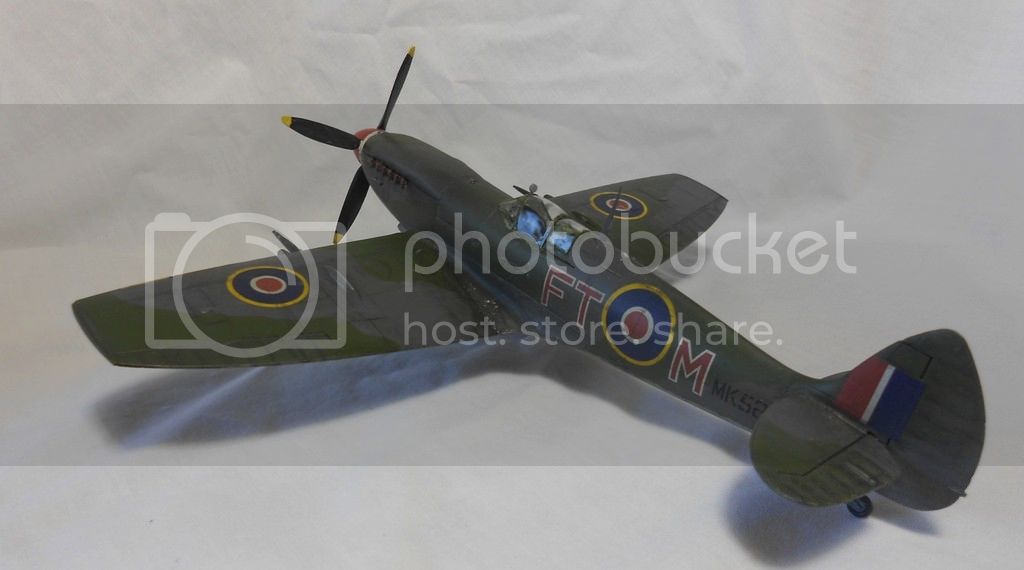1/48 Revell Germany Spitfire IX/XVI (Hasegawa rebox)
Paints: Golden High Flow Acrylics, Vallejo Model Color
Weathering: Flory Weathering Washes, Iwata Com.Art paints, Verithin pencils

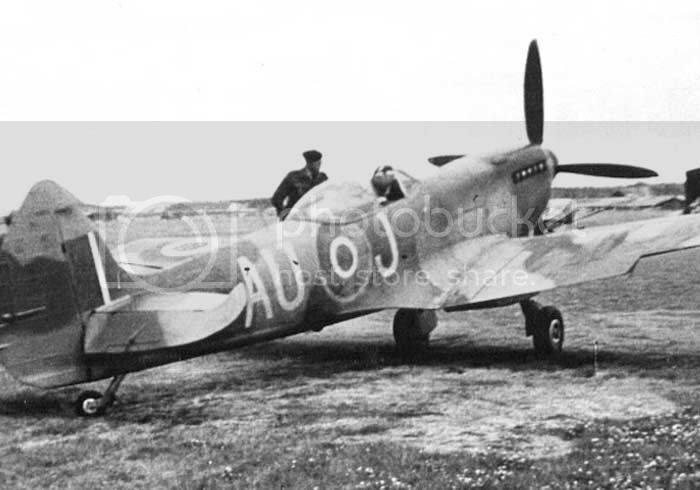

I built this for the 1945 Group Build at Finescale. The difference between a late version Spitfire IX and a Spitfire XVI is very slight principally the former has a British built Merlin and the later a US built Packhard Merlin. Either carried clipped wings but they were very common on the XVI (more later). I've got other Spits in the stash and most will have the universal or c wing, so I built this just to say I did so.
The Kit:

For the most part the kit is pretty good - fine detail and good fit. It has Italian decals that went on very well no small thing because there are a lot of them. There was some bad news that showed up later in the build. The kit only supplied a Malcom hood canopy the teardrop would have been really neat. (The black/white above is a XVI of the Canadian 144 Wing being serviced near the front. It has the teardrop and clearly shows frontline wear. The color pic is a recently restored 144 Wing Spitfire IX with late war camo minus the invasion stripes. The CO was Johnny Johnson, the RAF's top ace.) Worse, it came in three pieces that would really only work if assembled closed. That explains why the pilot's door engraved and not a separate piece. Cheap I think. And the canopy fit was a little dodgy and while fiddling into place a tad of Mico's clear part cement got on the inside without notice. Small mar, but ticked me off. I've been using Alclad's Glosscoat on clear parts and it kicks rear of Pledge and the pieces were shinny as day. Recommended. Revell neglected to put a little hole where the front frames meet for the rear view mirror. It was too evident to skip, so I had to drill a hole into parts connected with white glue very tricky, but it worked. Revell also didn't put a whole in the front of the fuselage for the prop connection to go, so I ended up eyeballing my own. That also worked but the sloppy engineering on the fringe of things reminds why people buy Tamiya aircraft.
The cockpit was more detailed than I would have expected considering the kit's mid-90s vintage. I did my duty. The belts were a decal which misfired. That made me mad so I looked around for a good way to scratch seat belts. Found a neat YouTube video that employs Aves Apoxy Sculpt which is very nice stuff. You roll it out very thing, like a pie crush, and cut very thin strips. Then lay them onto the seat. I liked the 3D approach and prefer them to PE. I could have got them better, but it was clear that no one was going to see the cockpit note I skipped the washes and don't regret it.
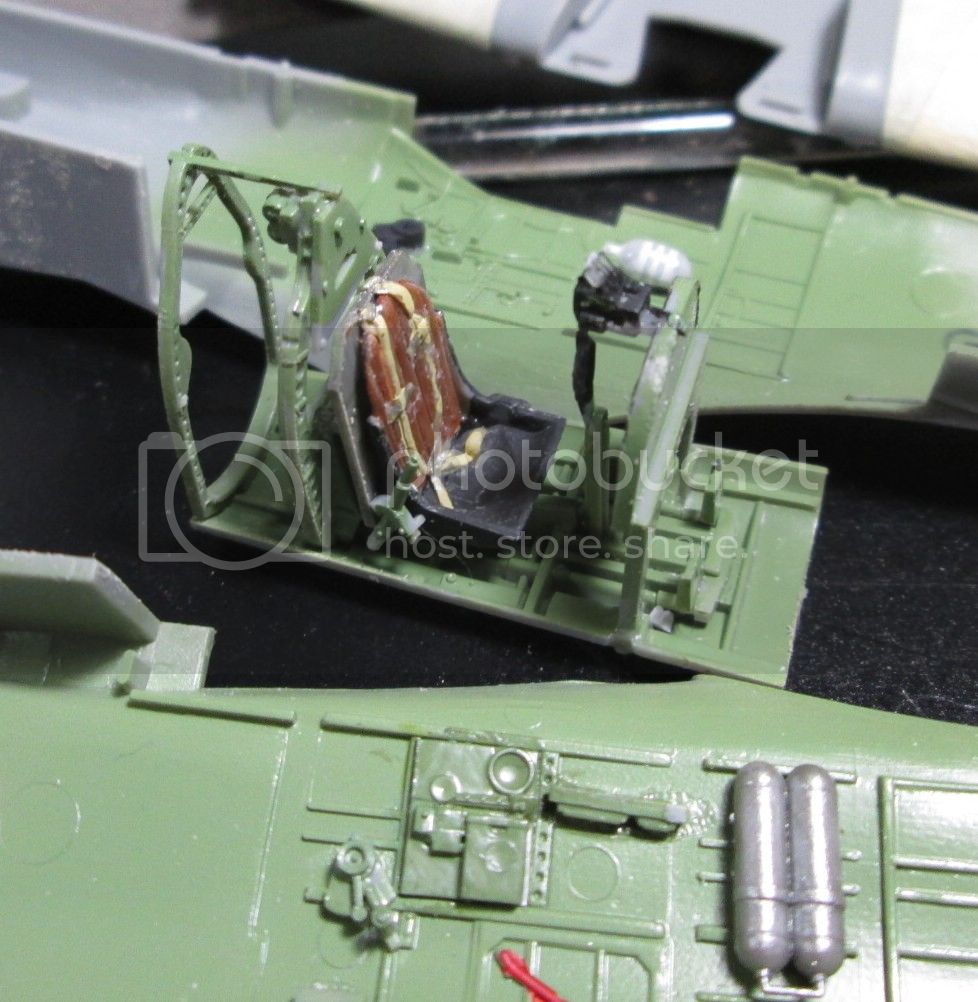
Painting:
I didn't take build pictures because, let's face it, this is just another 1/48 Spitfire one in a couple of million. There was a troublesome seam along the center, but fixable. Vallejo's excellent primer went on and everything was ready.

I will make a few comments about the painting. I like to try something new on every kit - probably guaranteeing that I'll never master any single approach. Keeps me awake though. On this model I used Golden High Flow paints. I've used them a little before and have been very pleased. They have 45 colors but nothing identified as military so you do need to do some mixing - which is genuine fun for me. (The cockpit is a High Flow mix and I think it looks good.) It is favored by some of the top gurus on Model Warship. It's a little hard to describe. Golden is the top producer of artist acrylics in the US and considered near the top world wide. In almost all Golden paints the agent is 100% polymer and the pigments top notch. Acrylics come in differing viscosity and until recently the thinnest was Golden Fluid. If you master the correct mediums and get used to it, Fluids are excellent in an airbrush and hand brush splendidly. (No surprise there.) Golden was first into the market but as I understand it, Vallejo was soon to follow. (Check their website half is dedicated to their art paints and mediums.) But Vallejo saw the modelling niche and have developed a vast variety of military colors that keeps growing. Vallejo Model Color is very close to Golden Fluid in viscosity (I often mix them) and works very well with an airbrush if you know the mediums. (Ironically, I don't think Vallejo suggests the right ones to use maybe because they're unfamiliar to many modelers. If you see a white colored Thinner Medium that's what you want as a start for a brew.) High Flow is more like Model Air same pigments, mostly the same agent, but considerably thinner. In earlier use I found it very airbrush friendly. It has a different feel than Model Air, and it's thinner. It has to have drying retarder and perhaps some self-leveling brew in it. In any case, this is the only paint I will use straight out of bottle after a really good shake: no thinner of any kind for use in a .20mm nozzle Harder Steenbeck Evo. (Comes in a terrific tear drop bottle with a BB inside and is about $4 for 1 ounce cheaper than Vallejo. It has 45 colors so you have to mix, but that's something I like.) Highly recommended to anyone that likes water based paints it's close to Tamiya with the airbrush and is far better by hand.
I had to make each color. The light sea gray underneath actually started out as a chromatic black with a slight blue tinge and lightened with gray. It was a bit too blue so a little black went in. Looks good. The dark gray on top is very dark and is neutral gray cut with some black. The green was just a bit of SAP green, but mostly yellow/black and raw sienna/gray. The result was a darkish green with a hint of khaki. I had good Model Color samples for each color and that helped a lot. When done the paint went on in several coats with low psi. There was zero tip clog although I always dab the tip with a damp paint brush every minute or less and the airbrush cleaned very easily. The paint laid down splendidly. Because the opacity and viscosity are high, very little paint was needed to cover, leaving even small detail nicely intact. It takes a little longer to dry, no doubt reflecting the retarder. When dry the finish is gloss and very hard - masking is zero trouble. Gloss just means you don't to put on pledge to do decals.
There was a lot of masking involved on top. This camo was so hard it must have been stenciled, so I had to copy the instructions. I traced it on with a mechanical pen and painted the gray as near to the line as possible. Then I masked it with silly putty. I would have preferred to use stuff called Panzer Putty which makes a very clean line, but it's so tacky that it comes off very easily. Silly putty stayed on and was pretty close some uneven edges were fixed by hand. Anyway, I think the model looked pretty good after the base coats were down.
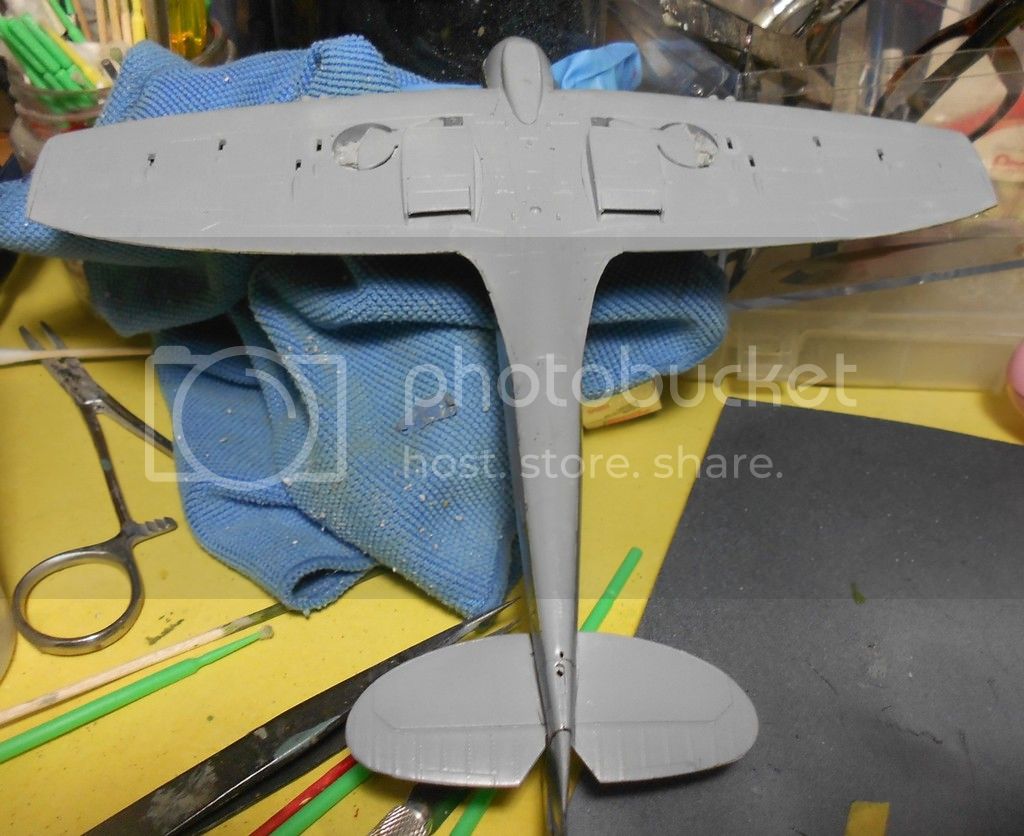

Weathering:
Weathering this kit was actually very challenging. I'm coming off a weathering orgy applied a Tamiya A6M2 Kamikaze, and didn't want anything like that. However, I wanted to emulate a plane that had been in service for a few months. This meant very little chipping (a bit on the prop, panels that would be removed for ammo or engine service and the wing where the pilot would climb in/out). However, an aircraft in service would be far from pristine. (Even a new one would have had several hours of check flights enough for a 1400HP engine to spew oil around.) Any RAF fighter would have been stationed outside, and Euro weather not sweet during the winter and early spring. So I'm thinking some fading and certainly dirt/grime build up but within limits. I found the middle of the road approach harder than emulating a plane factory fresh or badly beat up. I decided to try out the new series of Flory Washes. I put them over a satin/gloss finish after decals. Underneath I slobbered on the Grime color, and pulled most of it off did decent panel lines maybe a bit overdone, but that's my hang-up. (Personally, given scale effect, I'm not sure how well one sees minor panel lines from 50 feet away on an airplane I'd say not much. Your mileage may vary.) The wash leaves a little clay on, so if you go after it again, it's a grainy finish and more will stick. So I laid some down with an airbrush and paper towel roughly in accordance with airflow but never perfect. Nature is the enemy precise patterns. So here's what I came up with:
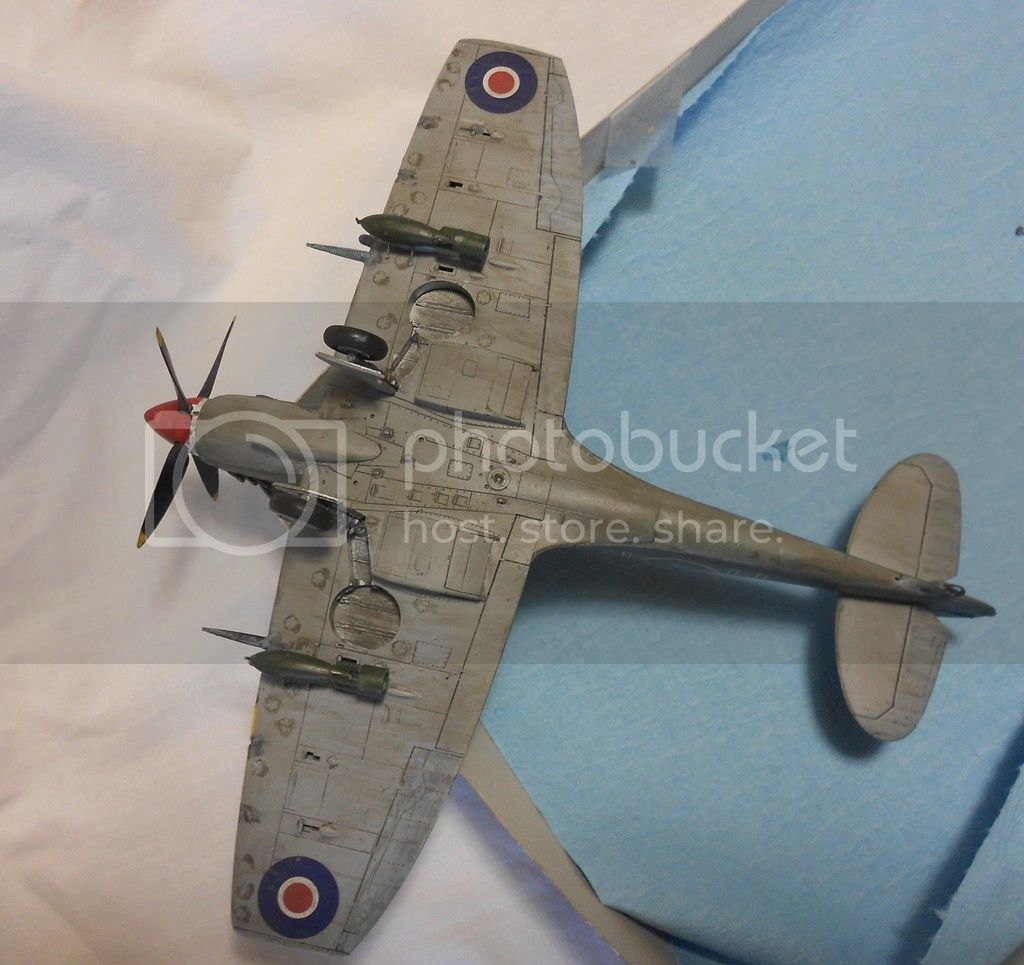
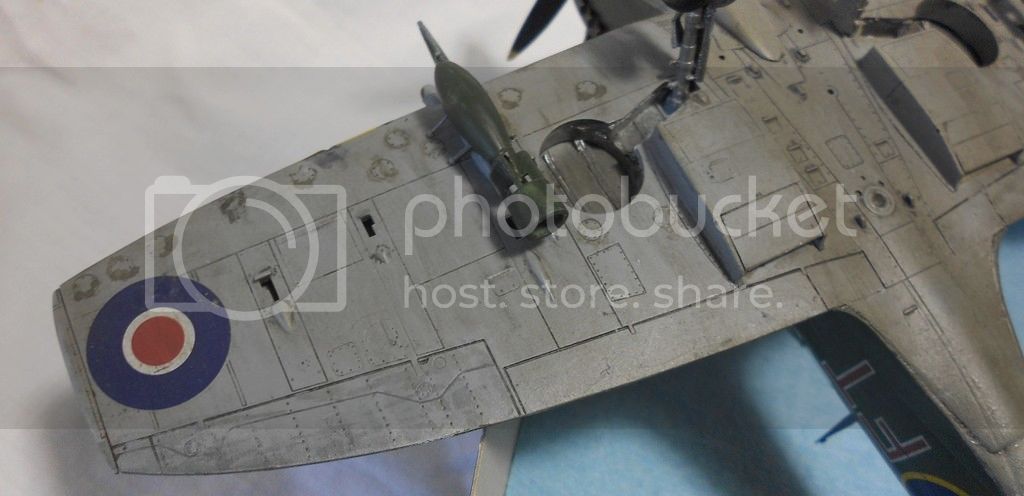
I was pleased with that. The upside was tougher. The gray used on the fuselage is considerably darker than on the bottom. That meant the washes could over darken it without care. I built it up slowly decent panel lines and a slight darkening which I did want. (On major panel lines I used a very sharp black Verithin pencil if clogged by wash: very effective.)Then I used pigments to fade both gray and green here and there on surfaces that got sun (again, no precision).
What happened was that the dark green (with a bit of khaki) started to lose the clear distinction with the dark gray and sort of melded into each other. That was really what I wanted.


I didn't want a dead flat finish. So that caused a little adventure. I mixed Vallejo satin and matte varnish and airbrushed it on the top. (I left the bottom alone the Flory wash finish was just right.) The effect was fine, but the finish a little grainy. I tried sanding it with very fine sponges, but that didn't really do the trick. Fortunately after applying a coat of Tamiya rattle can satin finish, everything looked fine, but a tad too bright. So I gave it a very light coat of Testors matte rattle can, and got it between matte and satin. That was fine.
Anyway, I can't really make any excuses here. It was a little tough to photograph (I enhanced a couple) but you can get a pretty good idea of what it looks like especially on the details. But the kit pretty much reflected what I wanted, so anything wrong (minus the usual bits of driver error) comes from my imagination and not my materials or execution.
I should say something about the RAF in late war. The UK did an utterly spectacular job producing a whole lot of aircraft including heavy bombers with an economy that wasn't ideally geared for it. (Not to mention naval, infantry and vehicle building.) The malaise that gripped Brit designers after WWI was shattered by Mitchell and Camm in the mid-30s. (The Bolton Defiant? Really?) And the aircraft coming from the UK were a splendid lot Hurricane, Beaufighter, Mosquito, Lancaster and of course the Spitfire. Minus the 262, the best of the British aircraft matched the best of the LW (the late war high altitude Spitfires matched up very well with Doras they might encounter which was rare. They surpassed any 109.) Their best planes could accommodate numerous updates and stay at or near the top. And let's not forget that the P-51 was RAF-US private company project done with little help from the USAAF.
And it usually showed in the sky. The Few created a real life epic. Rommel learned to hate the thought of the Desert AF. No German unit that engaged the Spit IX enjoyed it. Whatever you think of Harris, the Lancasters dropped an amazing load of bombs. There were bad moments. Churchill's odd attempt to keep air presence over the French channel coast in 41-42 led to ugly encounters between Spit Vs and early 190s. (Those flights and early Bomber Command raids kept most FWs out of the Russian Front for nearly a year.) But between 1940 and mid-44 it became painfully obvious that the RAF was not spared a design defect that afflicted every European air force, and harmed the USAAF until 8th AF decided bombers couldn't defend themselves. (Utterly astounding that many fighters weren't fitted for drop tanks until well into the war.) The role of long range escort had simply been missed. In practice this meant that the RAF, with its wonderful planes and pilots, largely missed out on history's greatest air battle the struggle for Germany's skies that raged from January 44 until September or so 1944. That was the moment for the great 8th AF P-51 groups that cut the LW to shreds. Had late model Spits been able to get to that battle the LW would have died sooner. (And it died. Germany had a lot of planes until 1945, but the pilots were rookies ready for the slaughter literally. There were the great aces but we killed most of them too.)
The RAF had a splendid renaissance over Europe after D-Day. There were fighter strips in Normandy even before Cobra after July every LW strip the allies captured had new owners. Many were flying Typhoons, Tempests and late model Spits. The farther the advance the more RAF fighters could take part in festivities over Germany. But most of the RAF single engine birds were part of the 2nd Tactical AF which meant every plane with a roundel was shooting up German ground targets. (All US fighters got into that act, including P-51s which may not have been bright.) The result was that while making the European landscape for anything that moved in German colors, RAF fighter squadrons were beginning to build their kill totals again at least until the LW more or less quit flying in the West in early 45. A specialty for allied planes was to fly standing patrols over any airbase large enough to accommodate LW jets. The 262 caused near panic for a few weeks, but it didn't take long before jets in the air grew scarce. BTW: as the war came closer to ground the clipped wing became common. It was originally put on the SpitV to aid its roll rate an important factor at altitudes under about 18,000 feet under FW guns. It also allowed in later Spit IXs an increased fuel load. Some of the late model Spits had outstanding high altitude performance, but the war for most planes went down in altitude after Normandy. (Ground support why the Red AF always favored low altitude performers like the LA5 even though their King Cobras and Migs had good high alt performance.)
The RAF certainly earned its supper and the gratitude of the free world during WWII, and it ended on a decided up note. Spitfire XIVs were a part of it.
Pics below.
Eric
